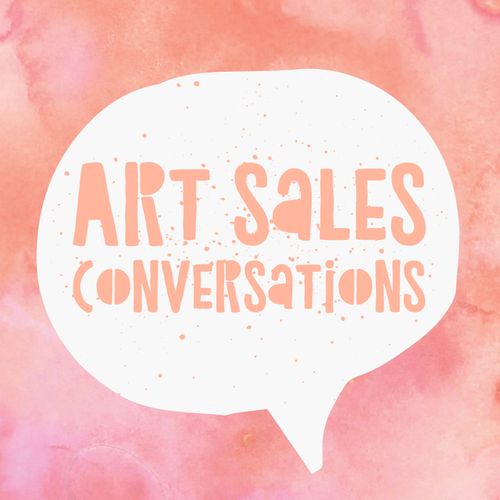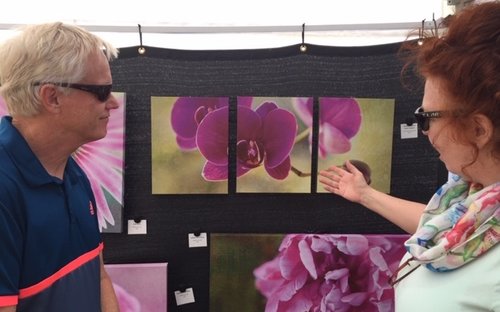by Carolyn Edlund
Many artists don’t have a high comfort level as a salesperson, but those skills can be learned. Here’s what you need to know about engaging in conversations that lead to a sale.

Selling Art is a Process
Running a small creative business isn’t easy, and selling art isn’t easy. The sales cycle in this business can be fairly long; collectors need to see your work, become interested, and understand the value before they will commit. After all, art is usually not inexpensive and it takes a lot of consideration on the part of the buyer first. Often there is more than one decision maker involved. And, it must be the right time for them to make a purchase. When all of this comes together smoothly, a sale can be made.
As the seller, you can’t reasonably expect to put your art out there and make sales consistently right away. Initial conversations rarely result in a transaction. They are often the beginning of a relationship where the prospect comes to know, like and trust you over time and eventually becomes a collector.
Statistically, only about 5% of sales are made on first contact, which means that as an artist who is serious about selling, you can count on doing a lot of follow up. But that first conversation is crucial because when handled skillfully, it can set the stage for sales to come.
If you are in the right place at the right time speaking to the right people, you may sell a work of art then and there. Let’s say you are at a fair and visitors are walking into your booth to see your art. Will you sell anything? At a busy event, the odds are that yes, you will. How can an artist/salesperson make the most of each conversation?

Photographer Kathleen Hall speaks with a visitor to her booth.
The Face-to-Face Conversation
When a new visitor steps into your show booth, smile and greet them. “Can I help you?” is one of the worst approaches. Instead, use a statement that breaks the ice and tells a bit about your work. Do you take macro photographs of flowers? Do you offer mixed media abstracts that have unusual materials? Is your art made with a specific technique? Give them a short introduction to your work to draw interest first, but don’t hover or follow them around the space.
As shoppers look through your inventory, you might point out a few items and answer questions. You should also ask questions as the conversation begins. Where are they from? What brought them to the show? Learning about your customers gives you information that can lead you to develop a target customer profile. Often artists find that their work appeals to a certain type of collector, and that knowledge can assist you in your marketing, presentation and your sales conversation.
Show and Tell
As the artist, you are the expert on your work, and have the most information to assist the prospect in making a decision. You know which mat and frame would look best with a print. You can answer questions about installing the art, care instructions or how to clean it. Make recommendations, and act consultatively in sales conversations. Most likely, the customer will really appreciate your assistance.
Touch is another important part of many purchases. Whenever possible, place the object under consideration into the customer’s hands, or encourage them to feel the surface or texture. This gives them a better understanding and deeper experience of your work. And, studies have shown that touch greatly increases the likelihood of a sale.
Features, Benefits and Objections
You already know the objections people have to buying your work, and can head them off before the show, or handle them in conversation. When a customer voices an objection, they may just be weighing their decision, and you don’t have to jump to answer every statement.
But if they ask a question or have a serious concern, acknowledge that through active listening. You might respond by repeating their thought, such as “I hear that you are worried this print might be too large for your wall space” and then suggest an option. Perhaps you have a smaller size available. Or, offer to take a return with no questions asked if it doesn’t work. Sometimes an objection can lead to a special commission, which is the perfect solution for that collector.
You also know the features and benefits of your work. Features are characteristics; benefits are how they affect the buyer. Your painted silk scarf can be hand washed (feature), which means it’s easy to care for and doesn’t require dry cleaning (benefit). Your giclee reproduction is a gallery-wrapped canvas (feature) which is ready to hang and doesn’t require a frame (benefit). The colorful handmade titanium earrings you are selling are strong and durable (feature) and can be confidently worn by active people without scratching or bending out of shape (benefit).
Since what people care about most is themselves, relating the benefits makes that connection and answers the question, “What’s in it for me?” Take a close look at how what you make offers clear benefits for the customer, and over time you will become fluent at sharing those benefits in sales conversations.
Speak to the Group
Quite frequently, fair goers attend with family or friends. When engaging in conversation, make eye contact with and speak to everyone present. This not only respects each person in the group, but can have positive benefits. Have you ever noticed that sometimes when a customer makes a purchase, their friend will do so as well? You may have had a prospect you didn’t know about. Or, you might learn when accepting payment that the friend was the one with the credit card all along.
On the other hand, if you pay no attention to the other party, they could become bored and suggest to your prospect that they move on and look elsewhere.
Ask for the Sale
When a shopper is leaning toward a purchase, they will give off buying signals, such as asking questions about the price or payment methods, delivery, or taking the next step. When the timing is right, ask. “Are you ready to take this home?” or “Shall I wrap it up?” Quite often, this will seal the deal.
If the prospective customer isn’t quite ready to make the commitment, they will let you know. Ask if there are any other details or concerns that can be resolved to make it happen. If not, don’t write off the sale yet. You have a very interested prospect for whom it is not quite the right time or circumstances to make a purchase, and you will want to stay in touch. In fact, since most people who look at your art won’t be buying anything that day, you’ll want to stay in touch with all of them, too.
Build Your List
Gathering names, email addresses, and even physical addresses should be a priority whenever you have the opportunity to meet people who are potential customers. Place a guestbook prominently in your booth, and suggest that visitors sign up to hear about your newest artwork, upcoming events and special offers through occasional emails.
If someone loves a piece of art but doesn’t buy, take a photo of it with your phone and offer to instantly email it to them with specifics, plus a link to your art website. Then, ask if you can stay in touch. That gives permission to put them on your email list.
Then, follow up through email marketing on a regularly monthly basis to help those fans come to know, like, and trust you and to remember your art. If you have a hot prospect who needs a phone call, personalized email message or even a visit to their home, take the time after the show to follow through and make the most of every opportunity.
Consider the first face-to-face meeting to be the beginning of a long relationship with your collectors. You will make sales, repeat sales and friends along the way. And your sales skills will be sharpened as you become the perfect spokesperson and representative for your own work.
Do you have a favorite sales story? What did you do to close the deal?



It’s reassuring to find that most of these suggestions are things I already do but I like the idea of taking a photo of something a customer is considering and emailing it to them – thank you!
Thanks Avril. Most of these are simple straightforward sales tactics that make sense for artists and anyone else making a sale. Glad you were able to pull out another tool to use in closing the sale!